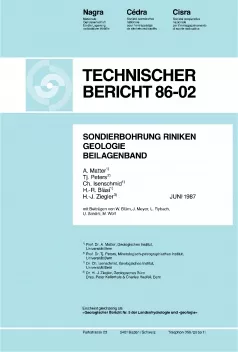
Technischer Bericht NTB 86-02
Sondierbohrung RinikenGeologie
The Riniken well was the third borehole of the NAGRA deep drilling programme, drilled after the wells of Böttstein and Weiach. Located in the borough of Riniken (Canton Aargau) on coordinates 656'603.80/ 261'799.50, at an altitude of 385.07 m above sea level it lies approximately 3 km NNW of Brugg railway station. The well reached a total depth of 1800 m.
Drilling at Riniken started on June 23, 1983 and continued until January 12, 1984. The well was almost entirely drilled using conventional rotary techniques. About 50% of the succession was drilled with roller bits and sampled only as cuttings; but the Opalinus Clay (Aalenian), the Liassic, the Middle Muschelkalk and the Buntsandstein were all continuously cored and much of the Rotliegendes was cored at selected intervals.
The comprehensive drillsite and laboratory studies included stratigraphic, sedimentological, mineralogical, petrographic and structural analyses in addition to a variety of petrophysical and geochemical investigations. This report presents all the data collected up until the end of September 1985.
The Riniken well penetrated the ca. 800 m thick Mesozoic Tafeljura sedimentary cover, and then drilled through ca. 1000 m of the clastic fill of the N Swiss Permo-Carboniferous trough. The succession encountered extended from the Effinger Beds (MaIm) down to the Upper Rotliegendes. The crystalline basement was not penetrated, but interpretation of the seismic data indicates its presence at depths between 3 and 7 km.
The cored sediments display occasional fissures. Most of these fissures are filled with clay minerals, calcite and quartz. Open fissures were encountered only in the Buntsandstein and in the Rotliegendes, at a depth of around 1005 m.
Water-saturated zones were recorded in the Schilfsandstein (Keuper), in the Trigonodus-Dolomit, in the Buntsandstein, and in the Rotliegendes between 950 and 1010 m. Water circulation is controlled partly by the presence of high porosity lithologies (e.g. Trigonodus-Dolomit, Buntsandstein) and partly by the occurrence of open fissures (e.g. in the Rotliegendes). However, most of the sedimentary sequence shows low permeabilities (K <10-10 m/s).
